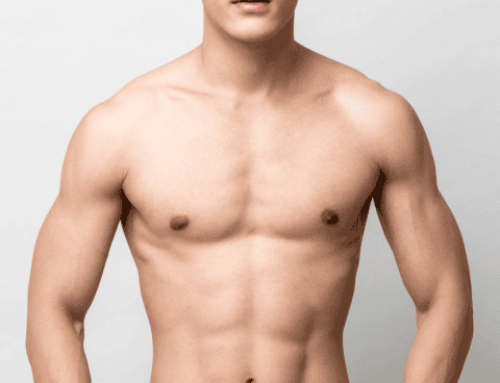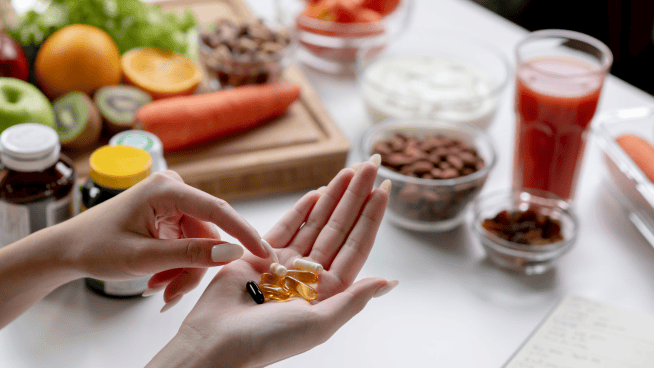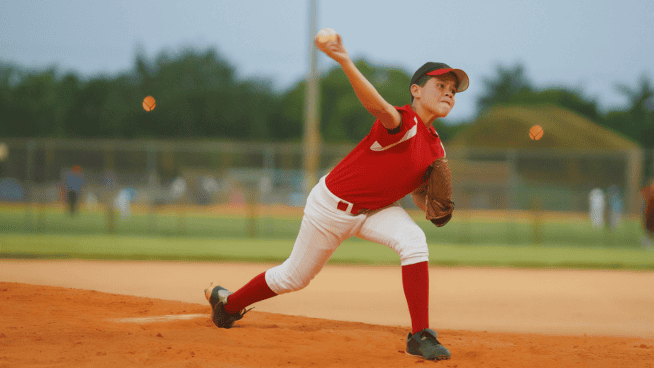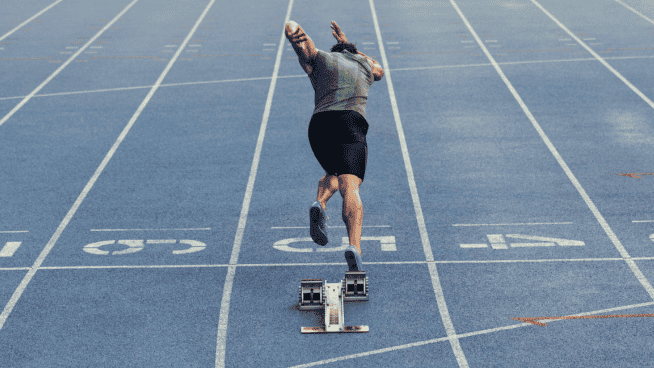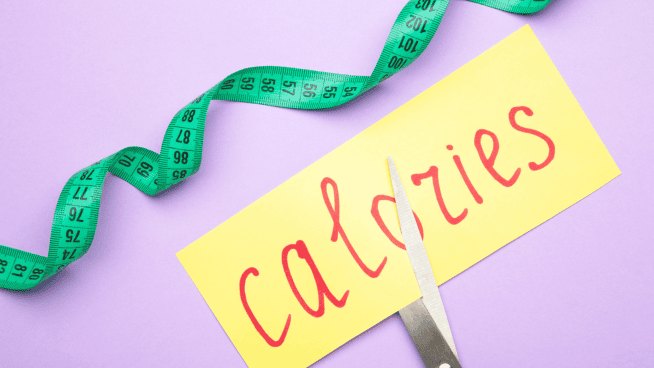6 Often-Overlooked Performance Attributes and How to Address Them to Become a Playmaker

1. Lateral Strength
In almost every sport, you move at angles more than you move straight ahead. Be sure your training hits all parts of the muscles required for your sport.
Messier Squats
Sets/Reps: 3×8 each leg
- Position your feet slightly wider than shoulder-width with your toes pointed slightly out.
- Keeping your chest up, sit your hips back and lunge to the side until your thigh is parallel to the ground.
- Straighten your opposite leg and point your toes toward the ceiling.
- Perform with your opposite leg, return to center and rise up out of the squat.
Variation 1: Hold a kettlebell in a front squat position for an added load (pictured).
Variation 2: Slow down the motion of the exercise by lowering into and rising up out of the Squat over three seconds.
2. Balance
Your body is strongest in a balanced state. However, during games, you often find yourself in an unstable position. Training for balance will help you make the play, even when you are in an uncomfortable position.
Single-Leg Cross-Body Squat
Sets/Reps: 3×10 each leg
- Stand on your right leg with your left hand reaching to the sky.
- Perform a Single-Leg Squat by sitting your hips back and keeping your knee aligned with your hips and toes.
- Do 10 reps and repeat with your opposite leg and hand.
Variation 1: Stand on a BOSU ball (pictured).
Variation 2: Never take your eyes off your hand (pictured). It will throw off your awareness and force your body to stabilize even more.
3. Deceleration
Making a winning play is not always about top speed. How fast you can stop is often more important. For example, a wide receiver may have to stop on a dime to fake out a defensive back, or a soccer player may quick-stop to dribble behind a defender.
Bulgarian Split Squat
Set/Reps: 3×8 each leg
- Place your right foot on a box or bench slightly higher than knee height.
- Take an exaggerated step forward with your left leg to assume a split stance.
- Keeping your chest up, bend your front leg and lower until your thigh is parallel to the ground.
- Straighten your front leg to drive up out of the squat.
Variation 1: Hold a dumbbell in each hand (pictured). Keep dumbbells aligned with your spine as you lower down.
Variation 2: Hold a dumbbell in the hand opposite your front leg. This will force your core to balance out the uneven weight between the two sides of your body.
Watch how to perform the Bulgarian Split Squat.
4. Mobility
The definition of mobility is “the ability to move freely and easily.” Athletes who are highly mobile are more likely to be at the right place at the right time to make a game-changing play.
Hip Swivels
Sets/Reps: 2×30 seconds each leg
- Standing on your right foot, raise your arms out to the side and bend your elbows to 90 degrees.
- Raise your left knee so that your thigh is parallel to the ground.
- Swivel your hips from side to side, going for as large a range of motion as possible.
- Try to keep your right foot in the same spot and stay on the ball of your foot.
- Keep your eyes and shoulders forward the entire time.
Variation: Hold a one- to five-pound dumbbell in each hand (pictured) to improve shoulder stability and help anchor the shoulders to stay square.
5. Full-Body Explosiveness
To be a playmaker, you must be able to control your entire body while you move in an explosive manner. One of the main reasons strength coaches recommend Olympic lifts is that they train athletes to do just that. Problem is, Olympic lifts should be avoided if they aren’t done correctly. Bodyweight exercises like the one below improve explosiveness and minimize the risk of injury.
Push-Ups to Pull-Ups
Sets/Reps: 3×15
- Start in push-up position with your chest on the floor.
- Hop your feet up past your hands.
- Jump up to a bar and do a Pull-Up.
- Hold your chin above the bar for two seconds.
- Drop back to the floor and do a Push-Up.
Variation: Have a partner signal when to hop out of the Push-Up.
Try these Push-Up variations.
6. Hand Quickness
Sports like basketball, lacrosse, baseball and football require quick, reactive, and coordinated hands. Yet hand quickness is often ignored in favor of foot quickness. Many professional athletes hit a boxing speed bag to enhance their hand quickness; however, I recommend Bar Flips to get the same benefit.
Bar Flips
Sets/Reps: 3×20 seconds
- Grab a bar that you can hold in front of you for at least 60 seconds (most high school athletes should use a 15- to 25- pound bar).
- Hold the bar vertically with your right hand on top and your left hand 8 inches below.
- Flip both your hands as fast as possible so that your left hand is on top and your right hand on the bottom.
- Repeat back and forth; the closer the bar is to your body, the easier it will be.
Variation: Stare at the top of the bar instead of your hands. This forces you to use your peripheral vision.
RECOMMENDED FOR YOU
6 Often-Overlooked Performance Attributes and How to Address Them to Become a Playmaker

1. Lateral Strength
In almost every sport, you move at angles more than you move straight ahead. Be sure your training hits all parts of the muscles required for your sport.
Messier Squats
Sets/Reps: 3×8 each leg
- Position your feet slightly wider than shoulder-width with your toes pointed slightly out.
- Keeping your chest up, sit your hips back and lunge to the side until your thigh is parallel to the ground.
- Straighten your opposite leg and point your toes toward the ceiling.
- Perform with your opposite leg, return to center and rise up out of the squat.
Variation 1: Hold a kettlebell in a front squat position for an added load (pictured).
Variation 2: Slow down the motion of the exercise by lowering into and rising up out of the Squat over three seconds.
2. Balance
Your body is strongest in a balanced state. However, during games, you often find yourself in an unstable position. Training for balance will help you make the play, even when you are in an uncomfortable position.
Single-Leg Cross-Body Squat
Sets/Reps: 3×10 each leg
- Stand on your right leg with your left hand reaching to the sky.
- Perform a Single-Leg Squat by sitting your hips back and keeping your knee aligned with your hips and toes.
- Do 10 reps and repeat with your opposite leg and hand.
Variation 1: Stand on a BOSU ball (pictured).
Variation 2: Never take your eyes off your hand (pictured). It will throw off your awareness and force your body to stabilize even more.
3. Deceleration
Making a winning play is not always about top speed. How fast you can stop is often more important. For example, a wide receiver may have to stop on a dime to fake out a defensive back, or a soccer player may quick-stop to dribble behind a defender.
Bulgarian Split Squat
Set/Reps: 3×8 each leg
- Place your right foot on a box or bench slightly higher than knee height.
- Take an exaggerated step forward with your left leg to assume a split stance.
- Keeping your chest up, bend your front leg and lower until your thigh is parallel to the ground.
- Straighten your front leg to drive up out of the squat.
Variation 1: Hold a dumbbell in each hand (pictured). Keep dumbbells aligned with your spine as you lower down.
Variation 2: Hold a dumbbell in the hand opposite your front leg. This will force your core to balance out the uneven weight between the two sides of your body.
Watch how to perform the Bulgarian Split Squat.
4. Mobility
The definition of mobility is “the ability to move freely and easily.” Athletes who are highly mobile are more likely to be at the right place at the right time to make a game-changing play.
Hip Swivels
Sets/Reps: 2×30 seconds each leg
- Standing on your right foot, raise your arms out to the side and bend your elbows to 90 degrees.
- Raise your left knee so that your thigh is parallel to the ground.
- Swivel your hips from side to side, going for as large a range of motion as possible.
- Try to keep your right foot in the same spot and stay on the ball of your foot.
- Keep your eyes and shoulders forward the entire time.
Variation: Hold a one- to five-pound dumbbell in each hand (pictured) to improve shoulder stability and help anchor the shoulders to stay square.
5. Full-Body Explosiveness
To be a playmaker, you must be able to control your entire body while you move in an explosive manner. One of the main reasons strength coaches recommend Olympic lifts is that they train athletes to do just that. Problem is, Olympic lifts should be avoided if they aren’t done correctly. Bodyweight exercises like the one below improve explosiveness and minimize the risk of injury.
Push-Ups to Pull-Ups
Sets/Reps: 3×15
- Start in push-up position with your chest on the floor.
- Hop your feet up past your hands.
- Jump up to a bar and do a Pull-Up.
- Hold your chin above the bar for two seconds.
- Drop back to the floor and do a Push-Up.
Variation: Have a partner signal when to hop out of the Push-Up.
Try these Push-Up variations.
6. Hand Quickness
Sports like basketball, lacrosse, baseball and football require quick, reactive, and coordinated hands. Yet hand quickness is often ignored in favor of foot quickness. Many professional athletes hit a boxing speed bag to enhance their hand quickness; however, I recommend Bar Flips to get the same benefit.
Bar Flips
Sets/Reps: 3×20 seconds
- Grab a bar that you can hold in front of you for at least 60 seconds (most high school athletes should use a 15- to 25- pound bar).
- Hold the bar vertically with your right hand on top and your left hand 8 inches below.
- Flip both your hands as fast as possible so that your left hand is on top and your right hand on the bottom.
- Repeat back and forth; the closer the bar is to your body, the easier it will be.
Variation: Stare at the top of the bar instead of your hands. This forces you to use your peripheral vision.








